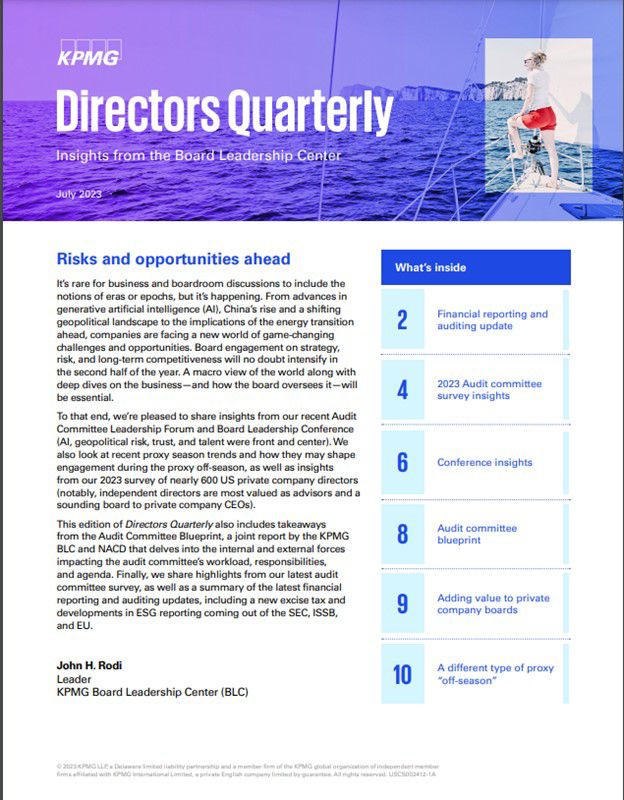Summary
In this edition, we share insights from our recent Audit Committee Leadership Forum and Board Leadership Conference (AI, geopolitical risk, trust, and talent were front-and-center). We also look at recent proxy season trends and how they may shape engagement during the proxy off-season, as well as insights from our 2023 survey of nearly 600 US private company directors (notably, independent directors are most valued as advisors and a sounding board to private company CEOs).
We also offer takeaways from the Audit Committee Blueprint, a joint report by the KPMG BLC and NACD that delves into the internal and external forces impacting the audit committee’s workload, responsibilities, and agenda. Finally, we share highlights from our latest audit committee survey, as well as a summary of the latest financial reporting and auditing updates, including a new excise tax and developments in ESG reporting coming out of the SEC, ISSB and EU.
JP Executive Insight features “Audit committee blueprint” below.
Audit committee blueprint
As part of NACD’s Future of the American Board initiative, the KPMG Audit Committee Institute/BLC and the National Association of Corporate Directors convened a Working Group to identify what has changed, and will change, for audit committees-internal and/or external forces and factors having the greatest impact on the committee’s work, responsibilities, agenda, and time.
While the audit committee’s core role-oversight of financial reporting, related controls, disclosures, and oversight of auditors-has not fundamentally changed, aspects of reporting itself are changing, and audit committees must stay current on developments in areas including ESG issues, cybersecurity, AI, and geopolitics. At the same time, the increased complexity and uncertainty of the business and risk landscape have raised the stakes and increased the workload of audit committees.
The report highlights 10 essential areas of audit committee focus designed to help every audit committee reassess its effectiveness and position itself for the future:
01 Financial reporting and related expertise: Stay focused on financial reporting and related internal control risks-job number one-and ensure that audit committee members have and maintain a level of financial literacy and expertise essential to the task, as that task continues to evolve.
02 Risk oversight: Continue to assess whether the risk oversight responsibilities assigned to the audit committee, beyond its core oversight responsibilities, are reasonable in scope; whether the audit committee is the right standing committee to oversee each of those risk categories; and whether the potential interconnectedness of critical risks is being evaluated.
03 ESG risk and disclosures: Clarify the role of the audit committee in overseeing the company’s climate and other ESG risks-particularly the scope and quality of ESG/sustainability reports and disclosures-taking into account changing regulatory mandates.
04 Talent in the organization’s finance function: Focus on leadership and talent in the finance function, and whether finance has the talent and skill sets to meet the evolving corporate reporting landscape as well as the organization’s information technology needs.
05 Audit quality: Reinforce the importance of audit quality and set clear expectations for frequent, candid, and open communications with the external auditor.
06 Internal audit’s value: Make sure internal audit is focused on the company’s key risks-including newly emerging risks-beyond financial reporting and compliance, and that it is a valued resource to the audit committee.
07 Transparency: Insist on transparency-both internal and external-among the board/audit committee, management, and the internal and external auditors.
08 Compliance and culture: Closely monitor the tone at the top and organizational culture-particularly across the finance/financial reporting function-with a sharp focus on yellow flags and behaviors (not just results).
09 Critical alignments: Help maintain critical alignments throughout the organization-culture, purpose, strategy, goals, risk compliance, controls, incentives, performance metrics, and people.
10 Audit committee focus and effectiveness: Make the most of the committee’s time together; effectiveness requires efficiency and advance preparation.
For more information, download the full report below.
The information contained herein is of a general nature and is not intended to address the circumstances of any particular individual or entity. Although we endeavor to provide accurate and timely information, there can be no guarantee that such information is accurate as of the date it is received or that it will continue to be accurate in the future. No one should act on such information without appropriate professional advice after a thorough examination of the particular situation.


